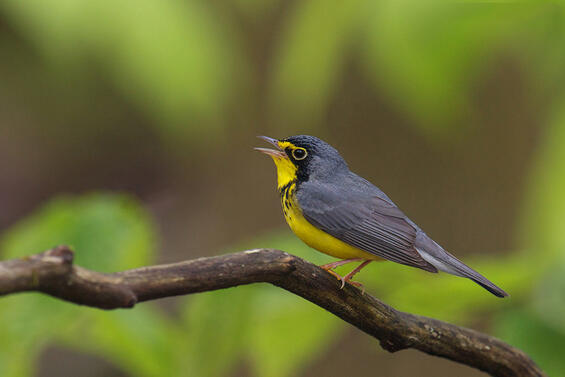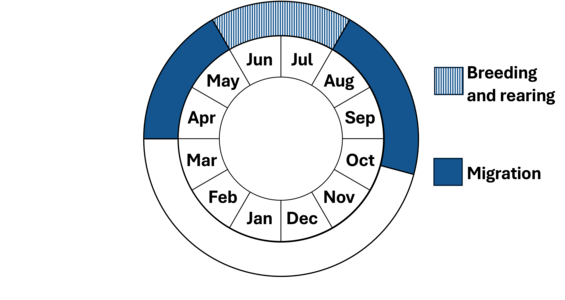- Scientific name: Cardellina canadensis
Species of Greatest Conservation Need (MA State Wildlife Action Plan)
Description

Canada warbler
The Canada warbler is a brightly-colored migratory wood-warbler 13-15 cm (5-6 in) long. Male and female plumages are similar, but the female is duller overall. The upperparts are bluish gray; underparts are bright yellow. The yellow and gray portions of the head are separated by black. The black area extends beneath the eye along the side of the throat to meet a series of vertical rows of black spots that form a "necklace" across the upper breast. The undertail coverts are white. Juvenile males are similar to adults, but duller, and the juvenile female is dullest of all, although adult markings are still recognizable.
Life cycle and behavior

Phenology in Massachusetts. This is a simplification of the annual life cycle. Timing exhibited by individuals in a population varies, so adjacent life stages generally overlap each other at their starts and ends.
Canada warblers reside in forest habitat in northern South America during the nonbreeding season and arrive in Massachusetts in early May to establish breeding territories in moist forests with dense understory structure. Males defend their territories through song and display behavior, and pairs form monogamous bonds during the breeding season. Nests are built on or near the ground in well-concealed locations, such as among moss-covered logs or at the base of uprooted trees. Females lay 3-6 eggs, which are incubated for about 10-12 days. Both parents feed the nestlings, which fledge after 8-10 days.
After the breeding season, Canada warblers migrate south beginning in late August. They are among the last warblers to arrive on breeding grounds in spring and among the first to leave in the fall. During migration, they rely on stopover sites with dense understory vegetation, before wintering primarily in the Andes Mountains of northern South America, from Venezuela to Peru.
Population status
Despite being unlisted in the Massachusetts Endangered Species Act, the Canada warbler has experienced significant population declines in recent decades. In Canada, Breeding Bird Survey results indicate a cumulative decline of 51% between 1970 and 2019 (Environment Canada 2020). However, the range-wide population appears to have slightly increased between 2000-2022. In Massachusetts, the species has been steadily declining over the past several decades, with habitat loss and fragmentation likely being significant contributing factors.
Distribution and abundance
The Canada warbler has a large breeding range that includes mixed conifer and deciduous forests from western Canada to New England and south along the Appalachian Mountains. In Massachusetts, it is an uncommon breeder from the Connecticut River Valley west and in northwestern Worcester County. It is rare in eastern Massachusetts and completely absent from Cape Cod and the Islands. The Massachusetts population is believed to be in decline based on data from the North American Breeding Bird Survey.
Habitat
In Massachusetts, Canada warblers occupy moist or swampy hardwood and mixed hardwood/conifer forests with dense undergrowth. Their diet consists of insects and spiders which are captured by hawking, hovering, and gleaning low in the understory. Nests are well-concealed in dense vegetation and are constructed on or near the ground.
Healthy habitats are vital for supporting native wildlife and plants. Explore habitats and learn about conservation and restoration in Massachusetts.
Threats
Habitat loss and fragmentation appears to be the primary threat to this species, which is considered highly area-sensitive. Active forest management can be compatible with sustaining Canada warbler populations. Generally, management practices that increase understory vegetation density (such as reducing deer density) enhance Canada warbler habitat, while practices which decrease understory density detract from their habitat. Canada warblers are vulnerable to habitat fragmentation as these areas often have an inflated nest predator community, including domestic cats, raccoons, and skunks, which take a high toll on the eggs and young of ground-nesting birds. Predation by domestic cats has been identified as the largest source of mortality for wild birds in the United States with the number of estimated mortalities exceeding 2 billion annually. Cats are especially a threat to those species that nest on or near the ground. Habitat loss on their wintering grounds in the Andes Mountains of South America continues to be a threat to Canada warbler populations. An additional threat to the species is collisions with buildings and other structures, as approximately 1 billion birds in the United States are estimated to die annually from building collisions. A high percentage of these collisions occur during the migratory periods when birds fly long distances between their wintering and breeding grounds. Light pollution exacerbates this threat for nocturnal migrants as it can disrupt their navigational capabilities and lure them into urban areas, increasing the risk of collisions or exhaustion from circling lit structures or areas.
Conservation
Habitat conservation efforts should prioritize the protection and restoration of large, contiguous tracts of moist hardwood and mixed forests with a well-developed understory. Management practices that promote understory vegetation density, such as reducing deer populations and implementing selective logging strategies that encourage natural regeneration, can enhance habitat quality.
Sustainable forestry practices should focus on maintaining structural diversity within forests, including retaining downed logs, shrubs, and dense understory layers. Conservation easements and land acquisition efforts can help prevent further habitat loss in critical breeding areas.
Nest predation can be minimized by maintaining understory vegetation and reducing human disturbance in known breeding areas. Public awareness campaigns aimed at reducing outdoor cat populations and promoting responsible pet ownership may also help decrease predation pressure on ground-nesting birds.
Promote responsible pet ownership that supports wildlife and pet health by keeping cats indoors and encouraging others to follow guidelines found at fishwildlife.org.
Bird collision mortalities can be minimized by making glass more visible to birds. This includes using bird-safe glass in new construction and retrofitting existing glass (e.g., screens, window decals) to make it bird-friendly and reducing artificial lighting around buildings (e.g., Lights Out Programs, utilizing down shielding lights) that attract birds during their nocturnal migration.
Supporting forest protection in the Andes Mountains of South America will promote the conservation of this species.
References
Government of Canada. “Canada warbler (Cardellina canadensis).” Species at Risk Public Registry, 2020. Accessed March 17, 2025.
Mass Audubon. “Canada warbler.” Mass Audubon Breeding Bird Atlases. Accessed March 17, 2025.
Cornell Lab of Ornithology. “Canada warbler Life History.” All About Birds. Accessed March 17, 2025.
Partners in Flight. “Canada warbler.” Partners in Flight Species Assessment Database. Accessed March 17, 2025.
BirdLife International. “Canada warbler Full Life Cycle Conservation Plan.” BirdLife International, 2021. Accessed March 17, 2025.
Reitsma, L. R., M. T. Hallworth, M. McMahon, and C. J. Conway (2020). Canada Warbler (Cardellina canadensis), version 2.0. In Birds of the World (P. G. Rodewald and B. K. Keeney, Editors). Cornell Lab of Ornithology, Ithaca, NY, USA. https://doi.org/10.2173/bow.canwar.02
Sauer, J.R., J.E. Hines, J.E. Fallon, K.L. Pardieck, D.J. Ziolkowski, Jr., and W.A. Link. 2022. The North American Breeding Bird Survey, Results and Analysis 1966 - 2022. Version 01.30.2015 , Laurel, MD.
Veit, R.R., & Petersen, W.R. (1993). Birds of Massachusetts. Massachusetts Audubon Society.
Contact
| Date published: | April 4, 2025 |
|---|